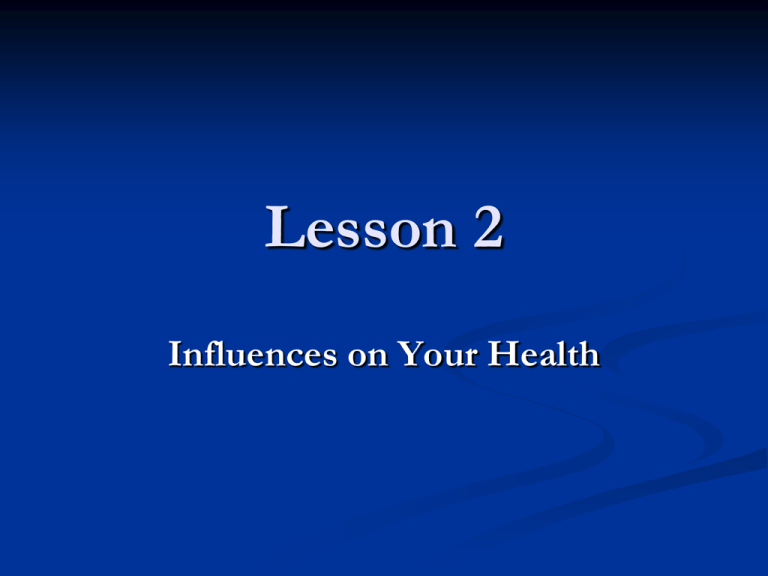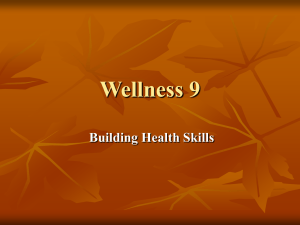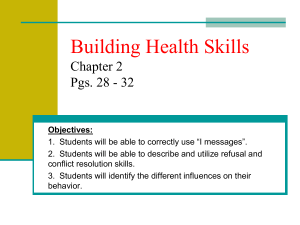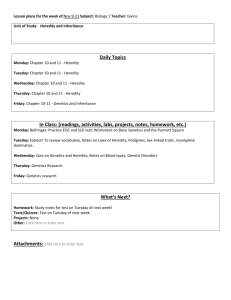Chapter 2 - Lesson 2
advertisement

Lesson 2 Influences on Your Health Chapter 1 Lesson 2 Objectives After this lesson you will be able to: 1. 2. Describe heredity, environment, and culture as influences on health over which they have little or no control Explain how behaviors and the choices and decisions you make affect your health. Influences on Your Health 1. 2. Activity 1 – Independent work What characteristics, likes and dislikes, and interests you have in common with other members of your family? Do you think your responses are due to heredity or to your home environment? This lesson will examine influences similar to these that can affect your health. Influences on Your Health Activity 2 – turn to a neighbor Define the following terms and provide examples for each term: 1. 2. 3. 4. Heredity Environment Peers Culture Heredity Heredity is all the traits and properties that are passed along biologically from both parents to child. To some degree, your general level of health was determined before you were born. The most obvious traits are physical ones. You also inherit basic intellectual abilities. Tendencies toward specific diseases can also be inherited. Environment Environment is the sum total of your surroundings, your family, where you grew up, where you live now, and all of your experiences. Environment includes the places you go in a given day and the physical conditions in which you live. It also includes the people in your life, your social environment. Yet another aspect of your environment is your culture. Physical Environment Your physical environment can affect all areas of your health. A person living in a clean and safe environment may be more likely to enjoy good physical and mental health. In contrast, a person living in an area with a high crime rate, for example, may experience stress and feel threatened for his or her personal safety. Physical Environment (Continued) Other aspects of your physical environment that can influence your health include air quality. Pollutants, such as smog and smoke from other people’s cigarettes, can increase your chances of developing lung disorders. Whereas growing up in a community with clean air lessens your risks of such diseases. Indoor aspects of your environment, such as a frayed electrical cord plugged into a wall socket, can also affect your personal safety. Physical Environment (Continued) Access to medical care is another aspect of one’s physical environment that influences health. The rising costs of medical care and health insurance in recent years, many people are unable to afford health services. Childhood immunizations are often overlooked, and this has led to a re-emergence of diseases that were once thought to be wiped out. Physical Environment (Continued) 1. 2. 3. Activity 3 – Independent work Describe characteristics of your physical environments. What parts contribute to a healthful environment? Are there aspects that pose risks to your health? Social Environment Your social environment includes your family and other people with whom you come into daily contact. A person who is surrounded by individuals who show support, love, strength, and encouragement may have a positive selfimage and, as a result, reach out and support others. A healthful, supportive social environment can even help a person to rise above adverse physical conditions, such as poverty. On the other hand, a person from an unhealthful social environment may suffer poor mental and emotional health as a result of rejection, neglect, verbal abuse, or other negative behaviors. Social Environment (Continued) An important part of your social environment, especially during the teen years, is your peers. Peers are people the same age who share a similar range of interests. Your peers include your friends and classmates. Peers who are loyal and supportive friends can help you grow mentally and socially. At the same time, peers who take part in dangerous, unhealthy, or illegal behaviors like using tobacco, alcohol, or other drugs can put pressure on you to be “part of the group.” Standing up to this peer pressure can be challenging. One way is by choosing friends who care about their health and yours. Social Environment (Continued) 1. 2. Activity 4 – Independent work Identify some of the choices and decisions you have made that were influenced by your peers. How does your social environment contribute to positive health behaviors? Cultural Environment Culture is the collective beliefs, customs, and behaviors of a group. This group may be an ethnic group, a community, a nation, or an entire section of the globe. The language your family speaks at home, the foods you prefer to eat, and the traditions and religion you practice are all part of your cultural environment. Cultural Environment (Continued) Understanding culture can help you understand yourself and get along with others. Culture can help you see what all people have in common. It can help you recognize the variety of ways in which people solve the same basic problems. Finally, your culture gives you a sense of identity as you take your place in a multicultural world. Your Behavior Although you have little or no control over your heredity and environment, you have a great deal of control over one factor affecting your life: your behavior. The way you choose to act within your environment and with your inherited abilities has a very important impact on who you are. Your Behavior (Continued) Suppose your family has a history of cardiovascular disease. Does this mean you must “follow in their footsteps”? Not at all! You can reduce your chances of developing this condition through positive choices and habits. You can reduce your intake of fried foods and other foods high in fat. You can also develop the positive habit of regularly participating in physical activity and exercise. Your Behavior (Continued) Similarly, if you are aware of environmental health influences, you have the ability to take positive action to protect your health. If there is a nonworking smoke detector in your home, you can replace the battery. You can wear sunscreen to protect your skin when you’re in the sun. If you know about the dangers associated with cigarette smoke, you can try to avoid being near smokers. By being aware—by becoming more health literate— you can take positive action to protect your health and the health of others. You can also take advantage of positive hereditary and environmental influences. Your Behavior - Your Health The simple fact is that the remainder of your life is, for the most part, in your hands. True, some factors influencing your health are out of your control, but most of the decisions affecting your health are yours to make. You and nobody else is in the driver’s seat. Take responsibility for your health and your life. Chapter 1 Lesson 2 Influences on Your Health Review 1. 2. 3. Define Heredity. Give an example of how heredity can positively influences your health. In your own words, define physical environment, social environment, and cultural environment. Explain how peer pressure can be a positive or negative influence in your life. Why is it sometimes difficult to resist? Tell why it is important to resist the pressure to do something that is dangerous, unhealthy, or illegal.









